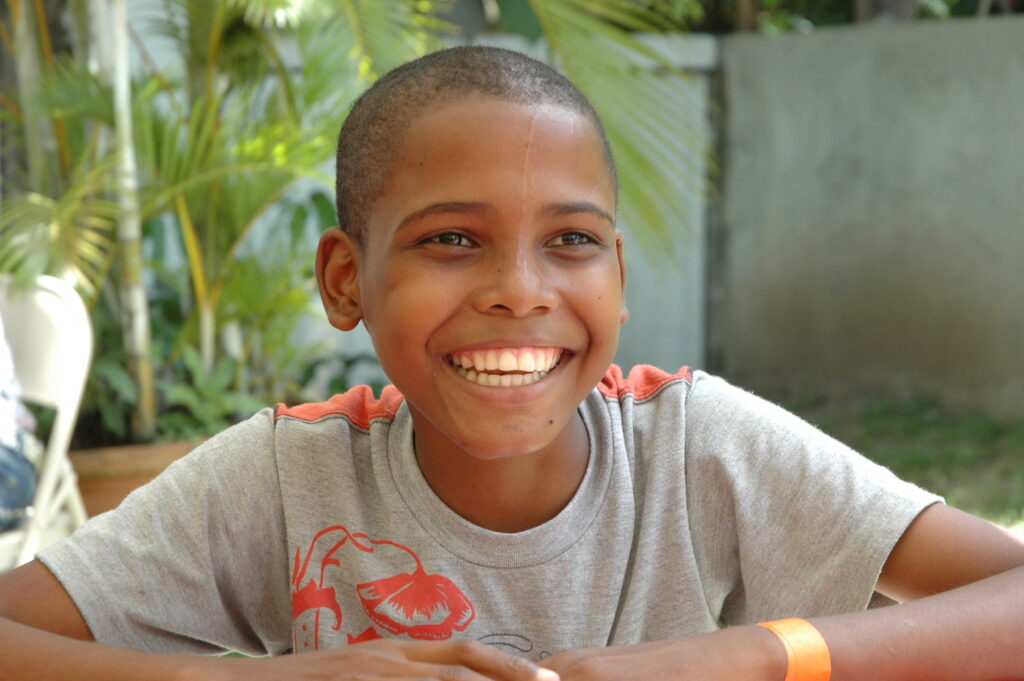Hot Fun in the Summertime
What could be more fun than attending a camp with 50 boys with hemophilia in the summer heat with activities, great food, camaraderie, a talent show, carnival games, swimming pool and meeting a world class celebrity?

Doing it in the Dominican Republic, a tropical paradise.
It’s the 10th anniversary of a remarkable camp, “Yo si pudeo!—Camp “Yes, I Can!” I would dub this one of the best, if not the best, camps for hemophilia in the developing world. And I know what it has taken to make it so as I was here for the very first camp in 1999.
Back then, as I told the staff today, I came to the DR give direction and advice. Things like: you need volunteers. You need to raise money. You need to quarter the medical area, preferably out of the dorms. You need Plan B for when it pours rain for three solid days. You need name tags, a list of each camper, and above all, you need factor. And factor can’t be stored with the raw meat.
It was a long learning process, but with each camp, the experience got better and better. I was delighted in 2005 to attend my fourth camp and saw not only a medical room, but also one under lock and key, clean and organized, with fresh flowers in a vase. Not only did the kids have nametags, but they had groups, which were named, and each group assigned a teen counselor. The counselors were the teens who grew up in camp. Amazing!
Ten years of camp came together seamlessly to create an awe-inspiring four days. The children were dropped off by family members on Thursday at the Robert Reid Memorial Hospital in Santo Domingo, the capital. I eagerly greeted the children I had come over 10 years to know and love, and met some new ones. Once assembled, they were hustled off to a chartered bus for the quick 25 minute ride to Lomas Linda, a lovely, lush town nestle in the hills. This was an exceptional venue—a private function house, with a huge wrap-around veranda on which were oversized chairs and hammocks, enticing visitors to relax. Parrots in cages, a pool table, gorgeous tropical flowers, I felt like I was back in colonial times, at a governor’s house in some far reaches of the world. Except, of course, for 50 Dominican kids with hemophilia having the time of their lives.
All the children were assigned to a group, distinguished by a color, and had color bands around their wrists so there was never a doubt which group they belonged to. And each child had a nametag, so that we could all learn one another’s names.



See all the photos of camp here!
https://lakelley.smugmug.com/InternationalTravel/Humanitarian/Dominican-Republic-Camp-2009/
The day begins at 7 am sharp with stretching on the lawn, headed by “Cuchito,” the coach and motivational man who showers the boys with love and discipline, and lots of fun. “Consado? (Tired?)” he shouts; “No!” the boys yell back while marching. “Alegre? (Happy?)” he shouts; “Si! (Yes!)” they reply. For 30 minutes they march, stretch, jump and loosen up, then eat a healthful breakfast. After that, there is pool, arts and crafts, rap sessions, educational seminars or rest times. The older boys look after the younger; and everyone is expected to participate, pitch in, and be the best teammate possible. It’s a successful recipe: the kids are attentive, behaved, active and happy.
One big surprise came when the kids were assembled outside the compound, eventually allowed back in through a series of “obstacles” as a group, with each obstacle an educational game about hemophilia at a table, staffed by maybe Dr. Rosa, their pediatric hematologist, or Dr. Joanne, the adult hematologist. When they passed through all the obstacles, they entered the main lawn of the compound, where there was a carnival! The center of attention was a huge, inflated slide which could and did hold up to 20 boys at one time, sliding, diving through tubes, climbing over inflated bars and then emerging at the end through two holes. No one seemed to notice when the clouds opened up and poured rain on everyone for about 20 minutes. Everyone beamed sunshine from within.
Many of the boys suffer permanent joint damage, and though young, walk with disfigured ankles, knees, and hips. I see Gabriel, who has a dazzling smile, trying to keep up with his friends by hopping-running-hopping-skipping-running to accommodate his crooked legs. He cannot be more than 15. Others have bleeds, and need to be reminded to stop playing and visit the medical ward. Though factor is a luxury here, being together with their hemophilic brothers is an even greater luxury, and one they don’t want to miss.
Today we came back to Santo Domingo, with stronger bonds and happier children. I hope to write more about the experience because so many wonderful things happened, and because it was our tenth anniversary.

I ended the day telling the staff that I used to come to the DR to give them advice on how to run the camp. Now I come to learn from them how to run a camp, and how to raise children with hemophilia when there are few luxuries, little medicine and no resources. Well, not no resources; the DR is rich in human resources, where creativity, hard work and dedication is changing the lives of so many children.
Check in again soon to read more and see the kids with their celebrity hero….










